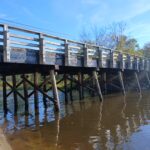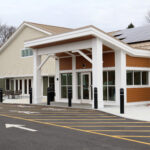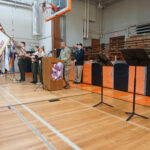The Conservation Commission approved the notice of intent for the application of the herbicide Clearcast to control invasive water chestnuts in the southern cove of Heard Pond. Heard Pond, which is bordered largely by U.S. Fish & Wildlife property and Pelham Island Road, forms part of the southern section of the 12-mile-long Great Meadows Wildlife Refuge and protected as a Massachusetts Great Pond.
ConCom asked for confirmation that the herbicide treatment would not impact the Sudbury River or the wildlife refuge. The Surface Water Quality Committee (SWQC) received a “no impact” statement from U.S. Fish & Wildlife, satisfying State Fish & Wildlife requirements.
Clearcast uses the active ingredient imazamox to selectively target specific aquatic weeds and quickly dissipates without leaving residues in fish and shellfish above food limits. SWQC member Tom Largey emphasized treatment must occur no later than early July before the mature plants drop 20–30 seeds each. Boat access would also become nearly impossible due to the plant density, he said.
Water chestnut management at Heard Pond has been ongoing for over 20 years. This year, SOLitude Lake Management contracted to treat heavily infested areas for $9,300 with Clearcast. Additional annual hand-pulling in less dense regions, already approved at $9,900, brings total costs to approximately $19,200 for fiscal year 2025.
On Dudley Pond, SWQC chair Tom Klem announced on June 18 a contract with Aquatic Restoration Consulting (ARC) for a pre- and post-season plant survey to inventory the current plant species and for assessing the town harvester’s effectiveness at removing tape grass at approximately $5,000. Annual water chemistry analysis was conducted on May 26.
ARC estimated $10,000 for sediment depth analysis which has not been checked since the early ‘80s. Dredging to remove sediment is considered a way to physically remove the nutrient base that enables weed growth on the pond and to complement removal by harvester or hand pulling.
However, having funded the outstanding contracts, the FY25 budget is exhausted. The approved $30,000 for FY26 will not cover both routine management and herbicide applications for both ponds. The seasonal budget planning indicates that herbicide invoices typically arrive post-treatment, allowing FY26 funds to be allocated for this year’s Clearcast.
The ProcellaCOR treatment for Eurasian milfoil in Dudley Pond, last applied successfully in 2023, is recommended every three years. A projected $60,000 cost for the subsequent treatment will need to be included in the FY27 budget. Select Board member Carol Martin advised that advanced notification be given to the Town Manager’s budget meetings.
Largey stressed the need for consistent operational updates regarding weed harvester activities on Dudley Pond and pointed to a current lack of timely information on harvesting progress. Martin clarified that town-employed operators, not volunteers, run the harvesters, recommending Klem communicate via the committee’s staff liaison, Kelsi Power-Spirlet. Klem agreed to reach out accordingly.
The board discussed documents posted to the Department of Public Works webpage about developing a Wastewater Needs Analysis for the Dudley Pond Area with Environmental Consulting & Technology, Inc. Klem plans to join the stakeholder committee representing the SWQC. Potential solutions include constructing a new treatment plant near Curtis Road or reactivating the defunct High School treatment system, pending a Tighe & Bond evaluation and possible DEP waiver.
The committee revisited PFAS monitoring at Dudley Pond, which is currently untested despite the availability of monitoring wells. Members supported baseline PFAS measurements due to potential contamination from any future remediation at 195 Main Street, but agreed it wasn’t urgent. Martin noted PFAS testing prioritizes drinking water sources over recreational bodies.
Lastly, the committee reviewed invasive plant sightings, including loosestrife and yellow iris at Lake Cochituate’s boat launch. Early intervention was encouraged, though no funds were currently allocated. Removal would require approvals from both the Department of Conservation and Recreation and the Wayland Conservation Commission.















